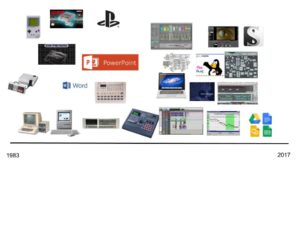
For this timeline I decided to focus on the hardware and software that has been most influential in my life. My earliest memories of computing were back in computer class as a kid using an Apple II. What I remember most about using the Apple II was playing Oregon Trail and a typing game where if you spelled a word incorrectly a fly would splat onto the car windshield. The Macintosh Classic was much more user-friendly and design-oriented. This computer had an understandable desktop interface and user-friendly tools for actually creating images and products like greeting cards and brochures. Concurrently, I was even more excited about different gaming systems, such as Nintendo, Genesis, and Playstation. Although I debated whether I should include gaming systems in a timeline related to design, I cannot overlook the interactive interfaces of gaming consoles as well as the potential for user design. For instance, in the NES game Excitebike, users were able to design their own levels. There was also a capacity for hacking, such as using cheat codes, for instance the infamous code for thirty lives in Contra— up, up, down, down, left, right, left, right, B, A, start.
When I started getting into recording music, a whole new set of design tools became accessible to me. The ADAT machine was capable of recording eight tracks of digital audio on a format that looked much like a VHS cassette. Doing this activity made me reminisce on all the various formats I was using to record data. For instance, my Alesis sampler could only hold sixteen seconds of audio on floppy disks. The Roland SP 808 sampler was a great advance, recording up to twenty-five minutes of audio on a zip disk. This sampler came with a screen to actually view data, and had some amazing functionality, being able to match sample tempos.
I then got into designing sound with software. The Pro Tools system I began using had almost unlimited potential in terms of audio-visual creation. Logic Pro has even more capabilities of integrating software instruments (VSTs) with audio. Max/MSP is a programming environment, where the user can actually build multimedia software. I recorded an album with Max/Msp created solely with software I built in Max and manipulated samples.
Some of my favorite design environments are open source software, some of it even intended for children. TuxPaint is a painting program intended for kids, but the environment is really fun and it actually produces interesting images. Sound Club is an open source audio sequencer for PC that I used for a number of years. It is extremely simple to use and comes with a cheesy set of sounds, from brass, to drums, and sound effects. Sound Club makes music that sounds like old video games, a sound I particularly like, growing up with the sound design of eight and sixteen bit gaming consoles.

One response to “ENGL 806 Timeline”